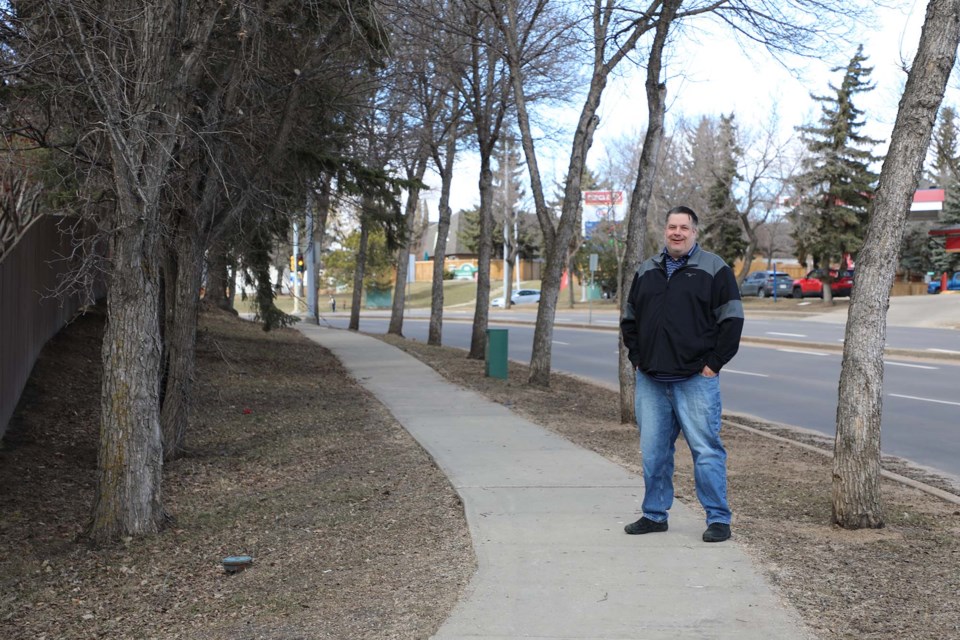A pig was one of the last things James Pitts expected to see running down Sir Winston Churchill Avenue as he was driving home one evening in March.
“I didn't think it was a wild pig at first because it looked very clean,” he said.
Roaming wild boars are an invasive species in Alberta and have been spotted across the province. On April 5, the province officially launched the Wild Boar Control Program, which expands the trapping and control program, compensates farmers, and gives bounties for each set of wild boar ears.
The program began on April 1 and will run until March 31, 2024. Landowners who work with government-approved trappers will be compensated $75 per set of ears per sounder — herd of feral hogs.
Hunters who turn in wild boar ears will also receive $75 per set.
The caveats?
“The trapping and hunting bounties are only in effect in participating counties,” said Bruce Hamblin, a spokesperson for Alberta Agriculture, Forestry, and Rural Economic Development in an email.
So far, the Municipal District of Peace No. 135 and the County of Stettler are the only participating counties.
“The programs started April 1, so it’s still early. We may see more participate as time goes on," said Hamblin. “The remuneration programs are available for any municipalities where we are not already conducting trapping and surveillance if they wish to participate.”
However, hunting wild boar is permitted throughout the province, said Hamblin, as long as general hunting rules are followed.
Wild boars are elusive creatures.
“To become a government-approved trapper a person will have to demonstrate to our provincial wild boar specialist that they have the skill, expertise, and equipment to capture an entire sounder (group) of wild boar at one time,” said Hamblin.
Hamblin said surveillance is important because wild boars are tough to count
“We’re not sure how many there are in the province — right now, any number would be a guess,” Hamblin said.
When asked if boars had been reported in St. Albert, Morinville, or Sturgeon County, Hamblin sent a link to a map.
Whether or not Pitts saw an at-large wild boar in St. Albert remains a mystery.
Hamblin said males typically travel by themselves and in March, would have been looking for food and partners.
On March 6, around 8:30 p.m., Pitts was driving down Levasseur Road towards the intersection of Sir Winston Churchill Avenue. As Pitts approached the lights, he saw an animal running north along Churchill, unleashed and by itself, crossing Levasseur in “perfect formation” on the sidewalk.
His first thought was that it was either a dog or a coyote, but the body was too big, he said.
“Once it went in front of the headlights, I noticed right away it looked like a pig — the shape of a snout and everything like that gave it away,” said Pitts.
Pitts said he had the green light and continued as it ran along the sidewalk up Churchill.
Pitts said he was confused and thought maybe someone had lost a pet pig.
“But a pretty big pet, right. Definitely not something that was selectively bred to be small. That was my first thought,” he said.
He didn’t think it was a wild boar at first because it looked clean and not like the wild pigs he had seen in Texas when he worked there. He described those pigs as darker and with a spikey ridge of fur down their backs.
Pitts said he then remembered hearing about some wild boars that had been spotted out in Parkland County a while back.
“That's not too far away. That's when I thought, well, maybe it could have been wild hog,” he said.
Pitts said the animal looked very much like the photos of wild boars on the Government of Alberta's website.
In Alberta, many wild boars are hybrids, said Hamblin, meaning they have been bred with domestic pigs.
"Typically, though, the wild boars we see in Alberta have the thick hairy bodies and long snouts," said Hamblin.
Hamblin said it isn't out of the realm of possibility that what Pitts saw was a wild boar, but he is hesitant.
"I suspect given the description I would lean towards this one not being a wild boar," he said
According to the province’s website, wild boars came to the province in the 1980s and 1990s as livestock. Some of the boars escaped and established wild populations.
Boars can damage property, agricultural crops, pastures, and the environment by altering ecosystems, contaminating water supplies, and they carry diseases.
According to a news release on the Alberta Pork website, there has been strong indication that feral pigs can be a significant route of transmission of many swine diseases. Wild boars can pass disease on to humans, pets, and livestock.
Boars prefer forest-cover habitats and can be found near water sources in the summer, and they build nests for shelter, said an Alberta government website.
Wild boars are omnivores and will eat anything from young livestock, the eggs of ground-nesting birds, plants, and insects.
Cory Sinclair, communications manager for the City of St. Albert, said the City has received one unconfirmed report of a wild boar — on the same weekend that Pitts saw his pig. But nothing else.
“We have not seen tracks, scat, or signs of rooting anywhere in the city to date. We will be monitoring, but seem to be boar-free at this point,” Sinclair wrote in an email.
Pitts said he reported his sighting to a provincial government website (https://www.alberta.ca/report-wild-boar.aspx), but not to the City.
Would Pitts like to see another pig?
“No, no, no, no. I don't need to see those just running free. It’s kind of unnerving.”




